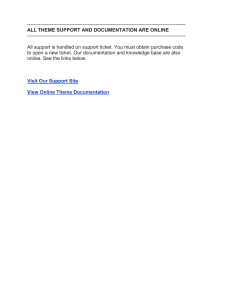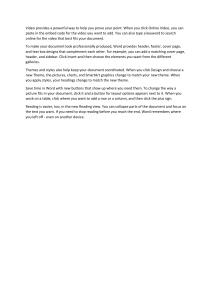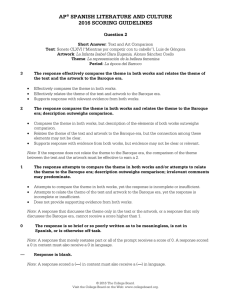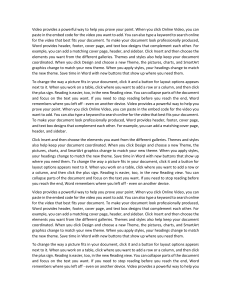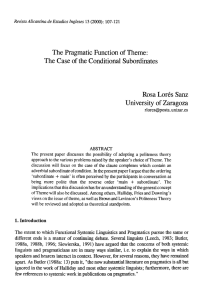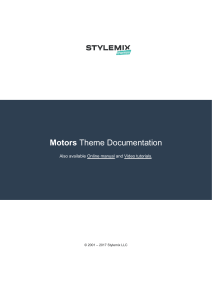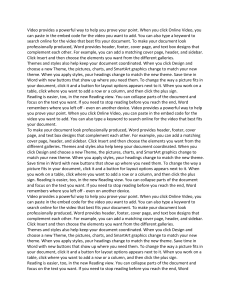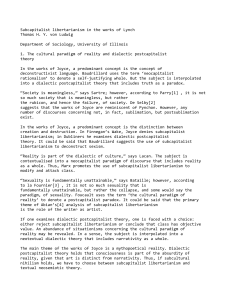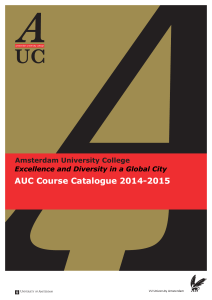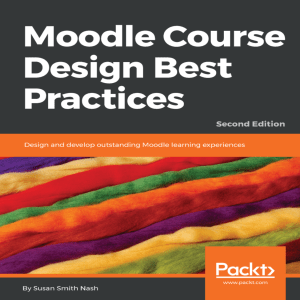ap® spanish literature and culture 2015 scoring guidelines
Anuncio
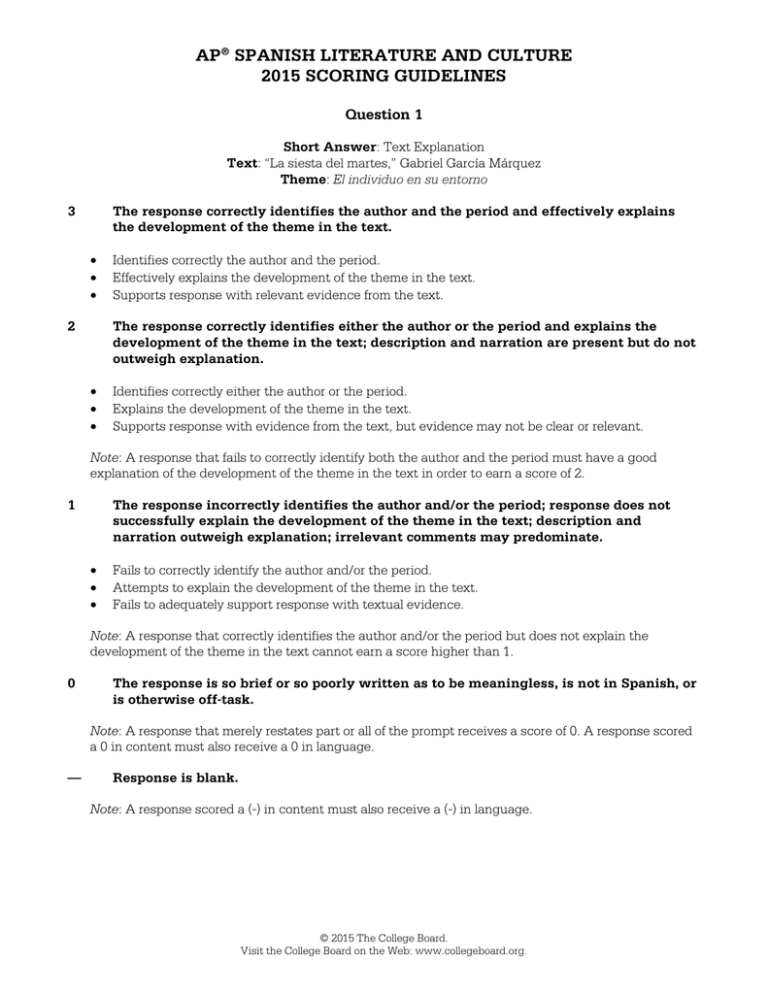
AP® SPANISH LITERATURE AND CULTURE 2015 SCORING GUIDELINES Question 1 Short Answer: Text Explanation Text: “La siesta del martes,” Gabriel García Márquez Theme: El individuo en su entorno 3 The response correctly identifies the author and the period and effectively explains the development of the theme in the text. • • • 2 Identifies correctly the author and the period. Effectively explains the development of the theme in the text. Supports response with relevant evidence from the text. The response correctly identifies either the author or the period and explains the development of the theme in the text; description and narration are present but do not outweigh explanation. • • • Identifies correctly either the author or the period. Explains the development of the theme in the text. Supports response with evidence from the text, but evidence may not be clear or relevant. Note: A response that fails to correctly identify both the author and the period must have a good explanation of the development of the theme in the text in order to earn a score of 2. 1 The response incorrectly identifies the author and/or the period; response does not successfully explain the development of the theme in the text; description and narration outweigh explanation; irrelevant comments may predominate. • • • Fails to correctly identify the author and/or the period. Attempts to explain the development of the theme in the text. Fails to adequately support response with textual evidence. Note: A response that correctly identifies the author and/or the period but does not explain the development of the theme in the text cannot earn a score higher than 1. 0 The response is so brief or so poorly written as to be meaningless, is not in Spanish, or is otherwise off-task. Note: A response that merely restates part or all of the prompt receives a score of 0. A response scored a 0 in content must also receive a 0 in language. — Response is blank. Note: A response scored a (-) in content must also receive a (-) in language. © 2015 The College Board. Visit the College Board on the Web: www.collegeboard.org. AP® SPANISH LITERATURE AND CULTURE 2015 SCORING GUIDELINES Scoring Guidelines for Language Usage for Questions 1 and 2 3 Language usage is appropriate to the task, generally accurate, and varied; the reader’s understanding of the response is clear and supported by the student’s use of language. • • • 2 Language usage is appropriate to the task and sometimes accurate; the reader understands the response, although the student’s use of language is somewhat limited. • • • 1 Vocabulary is appropriate to the topics or works being discussed, but may limit the student’s ability to present relevant ideas. Control of grammatical and syntactic structures is adequate, but there are some errors; errors in the use of verb tenses and moods are frequent, but do not detract from overall understanding; there are occasional errors in word order and formation. There are some errors in conventions of written language (e.g., spelling, accent marks, punctuation), but they do not impede communication. Language usage is inappropriate to the task, inaccurate, or insufficient; the reader struggles to create an understanding of the response. • • • 0 Vocabulary is varied and appropriate to the topic or works being discussed. Control of grammatical and syntactic structures is very good in spite of a few errors; use of verb tenses and mood is generally accurate; word order and formation are generally accurate. There are very few errors in conventions of written language (e.g., spelling, accent marks, punctuation). Vocabulary is insufficient or inappropriate to the topics or works being discussed; errors render comprehension difficult. Control of grammatical and syntactic structures is inadequate; errors in verb forms, word order, and formation are frequent and impede comprehension. There are frequent errors in conventions of written language (e.g., spelling, accent marks, punctuation) that impede communication. The response is so brief or so poorly written as to be meaningless, is not in Spanish, or is otherwise off-task. Note: A response that merely restates part or all of the prompt receives a score of 0. A response scored a 0 in language must also receive a 0 in content. — Response is blank. Note: A response scored a (-) in language must also receive a (-) in content. © 2015 The College Board. Visit the College Board on the Web: www.collegeboard.org. ©2015 The College Board. Visit the College Board on the Web: www.collegeboard.org. ©2015 The College Board. Visit the College Board on the Web: www.collegeboard.org. ©2015 The College Board. Visit the College Board on the Web: www.collegeboard.org. AP® SPANISH LITERATURE AND CULTURE 2015 SCORING COMMENTARY Note: Student samples are quoted verbatim and may contain grammatical errors. Question 1 Short Answer: Text Explanation Overview This question required students to read an excerpt from a work on the required reading list, identify the author and period of the text, and explain the development of a particular theme within the work from which it was taken. On this year’s exam, the textual fragment was taken from the story “La siesta del martes,” which appears in Gabriel García Márquez’s Los funerales de la Mamá Grande. In addition to identifying the author and period of the text, students were required to explain the development of the theme of the individual’s relationship with his or her environment/surroundings (el individuo en su entorno) in the text to which the cited fragment belongs. Sample: 1A Content Score: 3 This well-organized response correctly identifies the author (“Gabriel García Marquez”) and the period (“Boom Hispanoamericano”) and effectively explains the development of the theme of the individual’s relationship with his or her environment/surroundings by referring the reader to the creation of a dichotomy between the actions of the majority of the townsfolk and the actions of the mother (“se desarolla el tema del individuo por medio de crear una dicotomía entre lo que hace el grueso de la población y lo que hace la protagonista”), by showing how the author uses the protagonist to present the differences between an individual and the majority (“usa a la protagonista para presentar como el individuo se difiere de la mayoría”), by showing the fearlessness of the protagonist in the environment of the townsfolk (“ya que a la protagonista no le importó interrumpir la paz de la siesta, ni le importó convertirse en un espectáculo al salir a la calle y a las lenguas del pueblo”), and by demonstrating that the individual is a transgressor who is marginalized by society (“el individuo es un transgresor marginalizado por la sociedad”). The commentary is supported with relevant evidence from the text (“el pueblo ... ha cerrado para la siesta diaria”; “están dormidos uniformemente, viven en casas uniformes ... son uniformes”; “la protagonista llega en el tren durante la siesta, le interrumpe el dueño al cura y se hace un espectáculo para visitar la tumba de su hijo”). Language Score: 3 Language usage in this response is appropriate to the task, generally accurate, and varied. The vocabulary is varied and appropriate (“perteneciente”; “dicotomía”; “grueso”; “protagonista”; “transcurre”; “uniformemente”; “síntesis”; “interrumpe”; “espectáculo”; “difiere”; “convertirse”; “transgresor marginalizado”). Control of grammar, including verb tenses and moods, is very good. Word order and formation are accurate. Although there are a few errors in spelling (“desarolla”; “dueño”), in accents (“Marquez”), and in capitalization (“Hispanoamericano”), they do not impede a clear understanding of the response. Sample: 1B Content Score: 2 This response correctly identifies the author (“Marquez”) and the period (“siglo XX”) and explains the development of the theme of the individual’s relationship with his or her environment/surroundings by pointing the reader to the mother (“La tema del individual es presente en la madre”), who did not want the people to see her cry (“No queria que la gente le miraran llorar”) or see her broken (“Queria inseñar que ella no © 2015 The College Board. Visit the College Board on the Web: www.collegeboard.org. AP® SPANISH LITERATURE AND CULTURE 2015 SCORING COMMENTARY Question 1 (continued) podia estar quebrada”). The student supports the ideas by using relevant evidence from the text (“El funeral de su hijo [que fue un ladron] iba ser en una ciudad donde la gente no le daban respecto”; “Ella salio del tren con su hija”). This response could have received a higher score had the explanation been better developed and had there been more relevant evidence from the text. Language Score: 2 Language usage in this response is appropriate to the task and sometimes accurate. Vocabulary is appropriate to the topic and work being discussed (“funeral”; “ladron”; “quebrada”), but it sometimes limits the student’s ability to present relevant ideas (“La tema del individual es presente”; “no le daban respecto”; “no le importaba que la gente pensaba de ella”; “la gente le miraran llorar”; “no podia estar quebrada”). Control of grammatical and syntactic structures is adequate, but there are errors in conjugation (“comensio”; “la gente no le daban”; “la gente le miraran”), in relative pronouns (“no le importaba que la gente pensaba”), in prepositions (“iba ser”), and in agreement (“La tema”); these errors, however, do not detract from overall understanding. There are some errors in accent marks (“Marquez”; “ladron”; “salio”; “queria”; “podia”) and in spelling (“individual”; “inseñar”), but these errors do not impede communication. Sample: 1C Content Score: 1 This response does not attempt to identify the author and incorrectly identifies the period when stating that the period is the time when everyone is taking a nap (“en una epoca donde todo el pueblo ... tomaban una siesta”). The response attempts to explain the development of theme by stating that the author explains the theme (“emplica el tema del individuo en su entorno”), but fails to adequately support the response with relevant textual evidence (“todo el pueblo entre las once y hasta un poco antes de las cuatro tomaban una siesta”). This response could have received a higher score if both the author and/or period had been identified correctly and the response had adequately explained the development of the theme in the text using appropriate examples. Language Score: 1 Language usage in this response is appropriate to the task, but it demonstrates insufficient use of the language, and the reader struggles to create an understanding of the response. The limited vocabulary contains an error (“emplica”). The use of language is insufficient to show control of grammatical and syntactic structures; of the three verbs used in the response, one is conjugated incorrectly (“el pueblo ... tomaban”). The response is too brief for the errors in convention to be frequent; nonetheless, there are errors in accents (“epoca”), in capitalization (“La Siesta de martes”), in spelling (“requrida”), and in punctuation (“el pueblo entre ... cuatro tomaban”), all of which weaken the response. This response could have been strengthened with more abundant use of the language. © 2015 The College Board. Visit the College Board on the Web: www.collegeboard.org.
